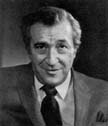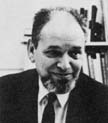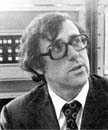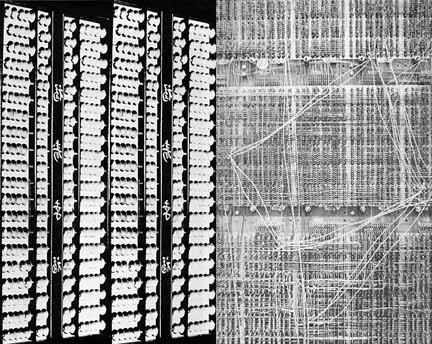
 |

Laboratory for
Computer Science(formerly Project Mac)
Massachusetts Institute of Technology
545 Technology Square
Cambridge
Massachusetts 02139
This is a brochure published by the MIT Lab for Computer Science in 1975, and gives a brief historical glimpse of our activities and faces twenty years ago.
 MIT has played an active role in the development of computer and
information related technology for more than four decades. Names
like Bush, Wiener, Shannon, and Forrester recall the differential
analyzer, the theories of communication, information and switching,
the Whirlwind computer and magnetic cores. More recently Project
MAC (now the Laboratory for Computer Science) was responsible for
another milestone in the development of computers: time-sharing.
The research currently being carried out by this leading Laboratory
is important and essential, as the computer field and its impact on
our everyday life continue to grow.
MIT has played an active role in the development of computer and
information related technology for more than four decades. Names
like Bush, Wiener, Shannon, and Forrester recall the differential
analyzer, the theories of communication, information and switching,
the Whirlwind computer and magnetic cores. More recently Project
MAC (now the Laboratory for Computer Science) was responsible for
another milestone in the development of computers: time-sharing.
The research currently being carried out by this leading Laboratory
is important and essential, as the computer field and its impact on
our everyday life continue to grow.Dr. Jerome B. Wiesner
 Computers and Information Processing are already playing a major
role in present day society. Future developments in Computer
Science will surely continue to occupy an important part of MIT's
teaching and research activities. Thus, it is important that there
exist a broadly based laboratory in which faculty, students and staff
from the several schools join for the purpose of advancing Computer
Science and pursuing its most challenging applications.
Computers and Information Processing are already playing a major
role in present day society. Future developments in Computer
Science will surely continue to occupy an important part of MIT's
teaching and research activities. Thus, it is important that there
exist a broadly based laboratory in which faculty, students and staff
from the several schools join for the purpose of advancing Computer
Science and pursuing its most challenging applications.
Professor Walter A. Rosenblith
 The Laboratory for Computer Science is a Massachusetts Institute of
Technology interdepartmental laboratory, whose principal goal is
research in Computer Science and Engineering.
The Laboratory for Computer Science is a Massachusetts Institute of
Technology interdepartmental laboratory, whose principal goal is
research in Computer Science and Engineering.Founded in 1963 as Project MAC (for Multiple Access Computer and Machine-Aided Cognition), the Laboratory developed the Compatible Time-Sharing System (CTSS), one of the first timeshared systems in the world, and Multics--an improved time-shared system that introduced several new concepts. These two major developments stimulated research activities in the application of online computing to such diverse disciplines as Engineering, Architecture, Mathematics, Biology, Medicine, Library Science, and Management.
Since that time, the Laboratory's objectives expanded, leading to a broad front of research activities that now span three principal areas. One of these is making programs more intelligent by capturing, representing, and using specific knowledge: Examples are the use of expert medical knowledge for diagnosis and drug administration carried out by the Clinical Decision-Making Research Group; the use of expert mathematical knowledge by the Mathlab Research Group for an automated mathematical assistant; and the use of knowledge in a specific domain in order to comprehend typed natural language (English) in that domain.
A second main focus of Laboratory research is making sizable improvements in the ease of utilization and cost effectiveness of computing systems: The Automatic Programming Research Group strives to reduce programming costs through the generation of inventory control programs by other programs, on the basis of high-level descriptions of desired activities, while another group strives for the same broad goal through structured programming, i.e., by imposing constraints on the programmer. Other examples include the automatic programming of microcomputer systems from higherlevel, domain-specific languages for the control of physical processes; and the study and synthesis of very large data bases. Finally, the architecture of individual "personal" machines and the organization of geographically distributed, more complex systems of computers, is studied from the point of view of exploiting the decreasing costs of processors and memories, improving overall performance and reliability, protecting information, and insuring privacy.
The Laboratory's third principal area of research involves exploration and development of theoretical foundations in Computer Science: The Theory of Computation Research Group strives to understand ultimate limits in space and time associated with classes of algorithms, while the Computation Structures Research Group searches for a combination of appropriate programming languages and machine architectures that insure trouble-free asynchronous computation by several processors.
A substantial fraction of the Laboratory's research involves applications outside computer science. Besides the clinical decision and mathematics areas discussed earlier, Laboratory members explore applications of computer technology in education; in management; in the control of physical processes; in the development of automated aids for composers of music and architects; and in the detection of information from noisy environments through the use of knowledge which is specific to that information. In addition to pursuing these technical research goals and applications, Laboratory members are interested in extracting educational material from new research results and in examining the societal impact of their work.
The Laboratory consists of 270 members--30 faculty, 80 support and professional staff, 130 graduate and 30 undergraduate students--organized into 13 research groups. The academic affiliation of most of the faculty and students is with the Department of Electrical Engineering and Computer Science. Other departments represented in the Laboratory membership are Mathematics, Architecture, Humanities (Music), and the Sloan School of Management. The Laboratory research is sponsored by governmental and industrial organizations.
Professor Michael L. Dertouzos

Allison Platt designed this brochure. The text was written by Michael L. Dertouzos.
All Photographs by Ivan Massar of Black Star except:

Please send site comments to our Webmaster.
Please see our notices about the content of this site and its usage.
(cc) 1998- Digibarn Computer Museum, some rights reserved under this Creative Commons license.